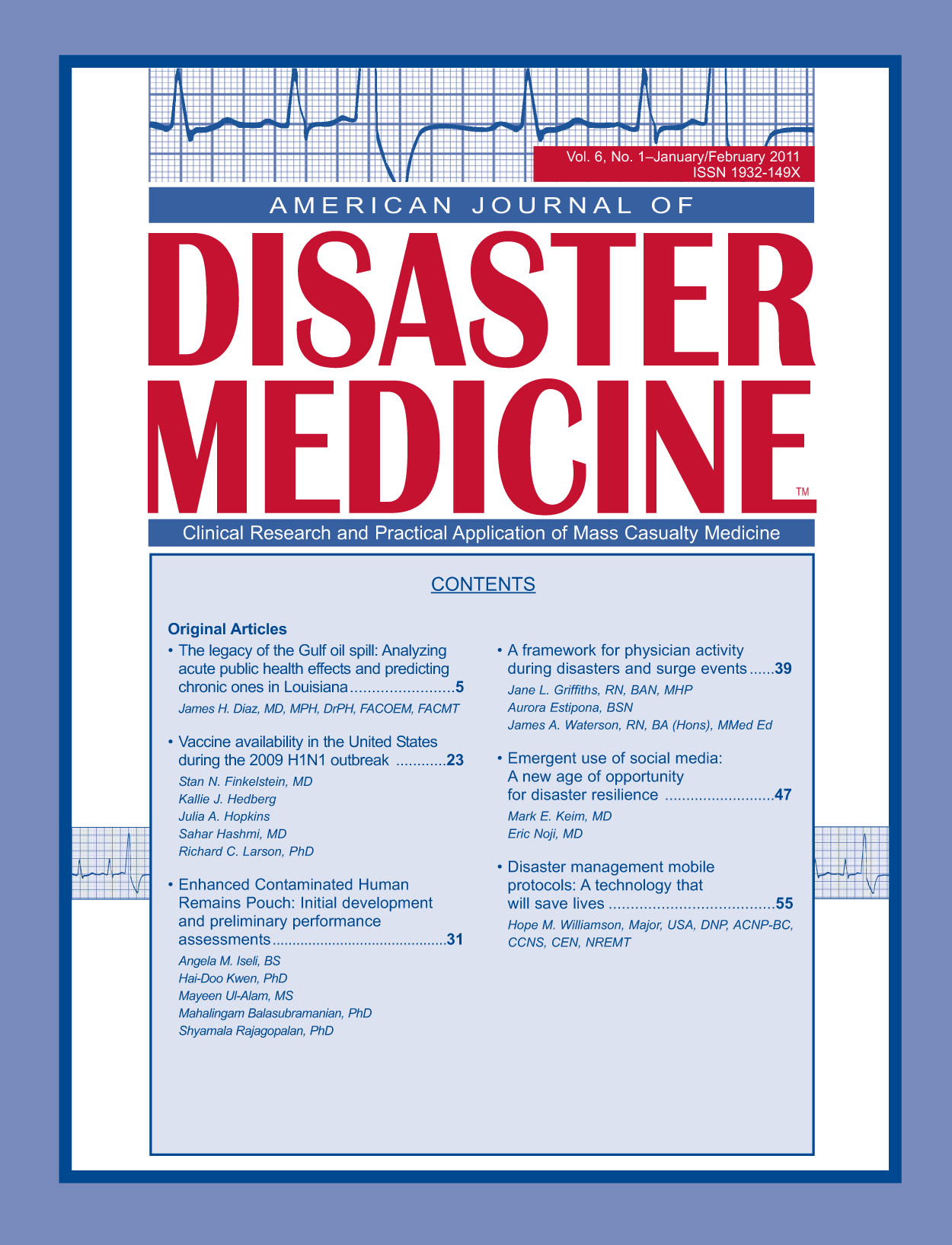Emergent use of social media: A new age of opportunity for disaster resilience
DOI:
https://doi.org/10.5055/ajdm.2011.0044Keywords:
social media, resilience, vulnerability, disaster management, peer-to-peer architecture, emergency response, information/communication technologyAbstract
Social media are forms of information and communication technology disseminated through social interaction. Social media rely on peer-to-peer (P2P) networks that are collaborative, decentralized, and community driven. They transform people from content consumers into content producers. Popular networking sites such as MySpace™,Facebook™,Twitter™, and Google™are versions of social media that are most commonly used for connecting with friends, relatives, and employees. The role of social media in disaster management became galvanized during the world response to the 2010 Haiti earthquake. During the immediate aftermath, much of what people around the world were learning about the earthquake originated from social media sources. Social media became the new forum for collective intelligence, social convergence, and community activism. During the first 2 days following the earthquake, “texting” mobile phone users donated more than $5 million to the American Red Cross. Both public and private response agencies used Google Maps™. Millions joined MySpace™ and Facebook™ discussion groups to share information, donate money, and offer comfort and support. Social media has also been described as “remarkably well organized, self correcting, accurate, and concentrated,” calling into question the ingrained view of unidirectional, official-to-public information broadcasts. Social media may also offer potential psychological benefit for vulnerable populations gained through participation as stakeholders in the response. Disaster victims report a psychological need to contribute, and by doing so, they are better able to cope with their situation. Affected populations may gain resilience by replacing their helplessness with dignity, control, as well as personal and collective responsibility. However, widespread use of social media also involves several important challenges for disaster management. Although social media is growing rapidly, it remains less widespread and accessible than traditional media. Also, public officials often view P2P communications as “backchannels” with potential to spread misinformation and rumor. In addition, in absence of the normal checks and balances that regulate traditional media, privacy rights violations can occur as people use social media to describe personal events and circumstances.References
Anonymous: Google Trends. Available at http://trends.google.com/trends?q_haiti%2C+hope+for+haiti%2C+haiti+another+earthquake+&ctab_0&geo_us&geor_all&date_2010-1&sort_0. Accessed November 19, 2010.
Kelly C: Haiti: Where to donate. Toronto Star; January 14, 2010. Available at http://www.thestar.com/news/world/article/750738. Accessed November 17, 2010.
Kates B: Haiti: Another earthquake—6.1 aftershock rocks shell-shocked Port-au-Prince. New York Daily News; January 20, 2010. Available at http://www.nydailynews.com/news/world/2010/01/20/2010-01-20_60_earthquake_strikes_haiti_strong_aftershock_sends_people_running_into_the_stre.html. Accessed November 17, 2010.
Anonymous: Stars raise money for Haiti earthquake victims.BBC News; January 23, 2010. Available at http://news.bbc.co.uk/2/hi/entertainment/8475971.stm. Accessed November 17, 2010.
Sutton J, Palen L, Shklovski I: Back channels on the front lines: Emergent uses of social media in the 2007 Southern California wildfires. Paper presentation at the 5th International ISCRAM Conference,Washington, DC, 2008.
Berkes F, Colding J, Foke C: Navigating Social-Ecological Systems. Cambridge: Cambridge University Press, 2002.
Vieweg S, Palen L, Liu S: Collective intelligence in disaster: An examination of the phenomenon in the aftermath of the 2007 Virginia Tech shooting. Paper presentation at the 5th International ISCRAM Conference,Washington, DC, 2008.
Hughes A, Palen L, Sutton J, et al.: “Site-seeing” in disaster: An examination of on-line social convergence. Paper presentation at the 5th International ISCRAM Conference,Washington, DC, 2008.
Wortham J: Burst of mobile giving adds millions in relief funds. New York Times; January 14, 2010. Available at http://www.nytimes.com/2010/01/15/technology/15mobile.html?_r_1&scp_1&sq_sysomos&st_cse. Accessed November 17, 2010.
United Nations International Strategy for Disaster Risk Reduction (UNISDR): UNISDR terminology on disaster risk reduction; 2009. Available at http://www.unisdr.org/eng/library/UNISDR-terminology-2009-eng.pdf. Accessed November 17, 2010.
Folke C, Carpenter S, Elmqvist T, et al.: Resilience and sustainable development: Building adaptive capacity in a world of transformation. Ambio. 2002; 31: 437-440.
Sundnes KO, Birnbaum PL: Health disaster management guidelines for evaluation and research in the Utstein style. Prehosp Disaster Med. 2003; 17.
Carpenter S,Walker B,Anderies JM, et al.:From metaphor to measurement: Resilience of what to what? Ecosystems. 2001; 4: 765-781.
Scheffer M, Brock W,Westley F: Socioeconomic mechanisms preventing optimum use of ecosystem services: An interdisciplinary theoretical analysis. Ecosystems. 2000; 3: 451-471.
The Sphere Project: Humanitarian Charter and Minimum Standards in Disaster Response. Geneva, Switzerland: The Sphere Project, 2008.
Laor N, Wolmer L, Spirman S, et al.: Facing war, terrorism, and disaster: Toward a child-oriented comprehensive emergency care system. Child Adolesc Psychiatr N Am. 2003; 12: 343-361.
Pant AT, Kirsch TD, Subbarao IR, et al.: Faith-based organizations and sustainable sheltering operations in Mississippi after Hurricane Katrina: Implications for informal network utilization. Prehosp Disaster Med. 2008; 23: 48-54; discussion 5-6.
Tierney K, Lindell J, Perry R: Facing the Unexpected: Disaster Preparedness and Response in the United States.Washington, DC: Joseph Henry Press/National Academy Press, 2001.
Federal Bureau of Investigation: Haiti earthquake relief fraud alert; January 13, 2010. Available at http://www.fbi.gov/scamssafety/e-scams. Accessed November 17, 2010.
Palen L,Vieweg S, Sutton J, et al.: Crisis informatics: Studying crisis in a networked world. Paper presentation at the Third International Conference on e-Social Science,Ann Arbor, Michigan, 2007.
Published
How to Cite
Issue
Section
License
Copyright 2007-2025, Weston Medical Publishing, LLC and American Journal of Disaster Medicine. All Rights Reserved.


